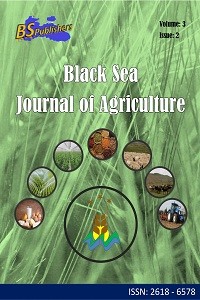Effect of Drip Lateral Spacing and Irrigation Amount on Tomato and Onion Crops Cum Water Productivity at Kobo Girrana Valley, Ethiopia
Abstract
Irrigation system in Kobo-Girrana valley is extensively developed into modern drip irrigation. Tomato and onion are among the major vegetables grown under drip irrigation. However, the drip lateral spacing was fixed to 1m for all irrigated crops. This leads to low crop water productivity, loss of land, less net return income and un-optimized irrigation production. An on-station experiment was conducted to determine the effects of drip line spacing and irrigation amount on yield, irrigation water use efficiency and net return income. The experimental treatments were: two lateral spacing of single (0.5 and 1m) row and double (1 and 2m) row corresponding to onion and tomato test crops and three irrigation amounts (pan coefficients /Kp/ = 0.8, 1.0 and 1.2). The experimental design was factorial arranged in RCBD. The experimental results revealed that there was an interaction effect between the lateral spacing and irrigation amounts on marketable yield and water productivity of the test crops. Application of 0.8 Kp with 2m lateral spacing and 1.2 Kp with 1m lateral spacing provided relatively higher marketable yield of tomato and onion respectively. Similarly, high water productivity was recorded with same irrigation depths and spacing. This result generally revealed that one lateral design for each two plant rows gave high net income than the one lateral design for each one plant row for drip irrigated fresh marketable yield of onion and tomato.
Supporting Institution
Amhara Agricultural Research Institute
Project Number
2
References
- Hartz, T.K., 1993. Drip irrigation scheduling for fresh-market tomato production. HortScience 28, 35–37.Hanson, B., Schwankl, L., Grattan, S.R., Prichard, T., 1994. Drip irrigation for row crops. Water Management Handbook Series 93-05. University of California, Davis, CA
- Allen, R.G., Pereira, L.S., Raes, D., Smith, M., 1998. Crop Evapotranspiration (Guidelines for Computing Crop Water Requirements). FAO Irr. and Drain. Paper No.:56, Rome.
- Pankaj, B., Narda, N.K., 1998. The effect of different sizesand orientations of wetted soil volume on root densityof trickle irrigated tomatoes. Ann. Biol. Ludhiana 4 (2), 155–159.
- Inan, I.H., 2001. Agricultural Economy. Trakya University, Agricultural Faculty, and The Notes for Students, 5th Press, Avci Offset, Istanbul (Publication code: ISBN: 975-93281-0-0,in Turkish).
- Narayanamoorthy, A. 2004. Impact assessment of drip irrigation in India: The case of sugarcane. Development Policy Review, 22(4), 443–462.
- Enciso, J.M., Colaizzi, P.D., Multer, W.L., 2005. Economic analysis of surface installation depth for cotton. Trans. ASEA 48 (IS-1) PS. 197-204
- Namara, R. E., Upadhyay, B., & Nagar, R. K. 2005. Adoption and impacts of microirrigation technologies: Empirical results from selected localities of Maharashtra and Gujarat States of India (Research Report No. 93). Colombo: International Water Management Institute.
- Keller, J., 2007. Irrigation technologies for small holders. Part II of paper under review for a special edition of Irrigation Science. (www.cahe.nmsu.edu/pubs/_circulars, 20.07.2007).
- Awullachew, S. B., Lambisso, R., Asfaw, G., Yilma, A.D. and Moges S.A. 2010. Characterizing, Assessing of performance and causes of underperformance of irrigation in Ethiopia. Ethiopian Journal Development Research.
- Shah, T., & Keller, J. 2014. Micro-irrigation potential in the developing countries. In M. R. Goyal (Ed.) Sustainable micro-irrigation: Principles and practices. Oakville: CRC Pres
- Ethiopian Panel on Climate Change (EPCC), 2015. First Assessment Report, Working Group II; Climate Change Impact, Vulnerability, Adaptation and Mitigation IV. Water and Energy, Published by the Ethiopian Academy of Sciences.
Abstract
Project Number
2
References
- Hartz, T.K., 1993. Drip irrigation scheduling for fresh-market tomato production. HortScience 28, 35–37.Hanson, B., Schwankl, L., Grattan, S.R., Prichard, T., 1994. Drip irrigation for row crops. Water Management Handbook Series 93-05. University of California, Davis, CA
- Allen, R.G., Pereira, L.S., Raes, D., Smith, M., 1998. Crop Evapotranspiration (Guidelines for Computing Crop Water Requirements). FAO Irr. and Drain. Paper No.:56, Rome.
- Pankaj, B., Narda, N.K., 1998. The effect of different sizesand orientations of wetted soil volume on root densityof trickle irrigated tomatoes. Ann. Biol. Ludhiana 4 (2), 155–159.
- Inan, I.H., 2001. Agricultural Economy. Trakya University, Agricultural Faculty, and The Notes for Students, 5th Press, Avci Offset, Istanbul (Publication code: ISBN: 975-93281-0-0,in Turkish).
- Narayanamoorthy, A. 2004. Impact assessment of drip irrigation in India: The case of sugarcane. Development Policy Review, 22(4), 443–462.
- Enciso, J.M., Colaizzi, P.D., Multer, W.L., 2005. Economic analysis of surface installation depth for cotton. Trans. ASEA 48 (IS-1) PS. 197-204
- Namara, R. E., Upadhyay, B., & Nagar, R. K. 2005. Adoption and impacts of microirrigation technologies: Empirical results from selected localities of Maharashtra and Gujarat States of India (Research Report No. 93). Colombo: International Water Management Institute.
- Keller, J., 2007. Irrigation technologies for small holders. Part II of paper under review for a special edition of Irrigation Science. (www.cahe.nmsu.edu/pubs/_circulars, 20.07.2007).
- Awullachew, S. B., Lambisso, R., Asfaw, G., Yilma, A.D. and Moges S.A. 2010. Characterizing, Assessing of performance and causes of underperformance of irrigation in Ethiopia. Ethiopian Journal Development Research.
- Shah, T., & Keller, J. 2014. Micro-irrigation potential in the developing countries. In M. R. Goyal (Ed.) Sustainable micro-irrigation: Principles and practices. Oakville: CRC Pres
- Ethiopian Panel on Climate Change (EPCC), 2015. First Assessment Report, Working Group II; Climate Change Impact, Vulnerability, Adaptation and Mitigation IV. Water and Energy, Published by the Ethiopian Academy of Sciences.
Details
| Primary Language | English |
|---|---|
| Subjects | Environmental Sciences |
| Journal Section | Research Articles |
| Authors | |
| Project Number | 2 |
| Publication Date | April 1, 2020 |
| Submission Date | October 20, 2019 |
| Acceptance Date | January 27, 2020 |
| Published in Issue | Year 2020 Volume: 3 Issue: 2 |


